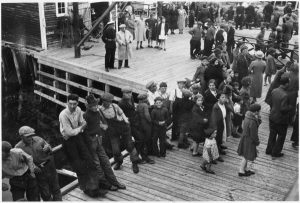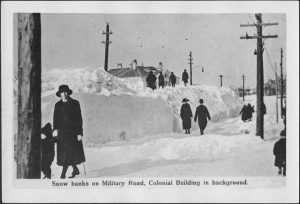ARCHIVAL MOMENT
July 26, 1888
There was much excitement in St. John’s on Thursday, July 26, 1888 with the official opening of a “City Opera House.”
Throughout the week the local newspapers were advertising the highly anticipated opening with bold headlines that proclaimed “A Grand Artistic Opening.” The advertisements encouraged residents of St. John’s
“to reserve their tickets during the day, at J.W. Foran’s Confectionary Store, Atlantic Hotel Building to avoid the crush at the Ticket office.”
The Tickets did not come cheap!!
Admission for Reserved Seats (Dress Circle) 75 cents; Orchestra Chairs, 50 cents; Gallery Chairs, 30 cents; Parquette, 20 Cents and the luxury of a box seat a whopping $6.00.
The proprietor of the Opera House was the St. John’s businessman J.W. Foran who was well established at the J.W. Foran Confectionary Store in the Atlantic Hotel Building. In his advertisements he stated:
“The proprietor of the city opera house (Mr. J. W. Foran) seeing the great want of a place of musical and dramatic talent, of which the rising generation have not had the advantage of hearing or seeing, has suited the opera house with all modern improvements, suitable for the production of entertainments of the very highest order – thus giving the people o St. John’s an opportunity of hearing some of the best musical talent in America. The establishment of such a space means a very large outlay, and it is to be hoped that the public will give it that substantial support which will warrant its permanency. The season will commence with the famous San Francisco Minstrels”
This talented group from San Francisco was under the management of Charles L. Howard. Engaged for a limited season only, the cost of transportation alone was nearly one thousand dollars. Before each performance, a Grand Balcony Serenade was to be given by the Silver Cornet Band.
Reviews of the performances during the following week stated that the
“minstrel’s are nightly drawing large and respectable audiences. They have advanced considerably in the estimation of our people since their first appearance which did not give the satisfaction anticipated and are steadily increasing in popularity.”
This was the first Opera House in St. John’s, but was not the first opera.
The first opera performed in Newfoundland, Thomas Linley’s The Duenna; or the Double Elopement, was presented in May 20, 1820 as a benefit for the victims of the great fire of 1817. The Duenna is a three-act comic opera, was considered one of the most successful operas ever staged in England. Lord George Byron called it “the best opera ever written”).
Recommended Archival Collection: At the Rooms Provincial Archives take some time to look at MG 343.1 the script for Patience: a new & original aesthetic an opera written by W.S. Gilbert, Composed by Arthur Sullivan , 12 Apr. 1883. Item consists of Opera that was “given in aid of the poor by a number of amateur ladies and gentlemen at the Star of the Sea Hall, St. John’s”.
Recommended Virtual Exhibit: How did a young girl from an outport community on the northeast coast of Newfoundland gain international recognition on the stages of the world? http://www.museevirtuel-virtualmuseum.ca/sgc-cms/histoires_de_chez_nous-community_memories/pm_v2.php?lg=English&ex=00000469&fl=0&id=exhibit_home
Recommended: Opera on the Avalon (OOTA) is Canada’s newest opera company in the oldest city in North America. Opera on the Avalon: http://operaontheavalon.com/about/












